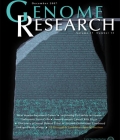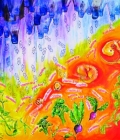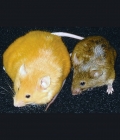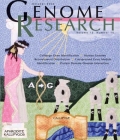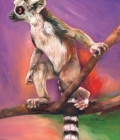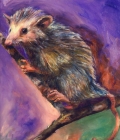Dr Jirtle receives Linus Pauling Award
Institute for Functional Medicine
At the Institute for Functional Medicine’s 2014 Annual International Conference, held May 29 – 31, 2014 in San Francisco, California, Randy L. Jirtle, PhD, was honored by receiving the Linus Pauling Functional Medicine Award. The Linus Pauling Award has been presented by the Institute for Functional Medicine (IFM) since 1996 to clinicians and researchers whose work has pioneered important principles in the Functional Medicine model. Jeffrey Bland, PhD, IFM Chairman Emeritus, had this to say about Dr. Jirtle’s selection as the 2014 Linus Pauling Functional Medicine Award recipient:
“He is an extraordinary discoverer who crossed the boundaries of disciplinary myopia to become the father of environmental epigenomics. I also call him the father of nutritional epigenetics because of the important observation he has made as to the role that nutrients play in developmental biology and modulating the epigenome’s expression into the phenotype. In his work at Duke, with his post-doctoral student Dr. Robert Waterland, they made what I would consider one of those frame-shifting, epic, seismic discoveries that the nutritional environment of the pregnant animal will influence the phenotypic outcome of the offspring.”
- Award Lecture
May 31, 2014
- Award Presentation
May 31, 2014
- Institute for Functional Medicine
May 31, 2014
July 19, 2014Tweet
NIH Wednesday Afternoon Lecture Series
On April 18, 2012, Dr. Jirtle delivered a lecture on "Epigenetics: How Genes and Environment Interact" as part of the NIH Director's prestigious Wednesday Afternoon Lecture Series.
August 9, 2012Tweet
Person of the Year 2007 Nominee
Nora Volkow, Director of the National Institute on Drug Abuse and pioneer in the science of addiction, nominated Dr. Jirtle to be Time Magazine's Person of the Year 2007.
I'd select the Duke University scientist whose pioneering work in epigenetics and genomic imprinting has uncovered a vast territory in which a gene represents less of an inexorable sentence and more of an access point for the environment to modify the genome. The trailblazing discoveries of Dr. Randy Jirtle have produced a far more complete and useful understanding of human development and diseases.
- Time Magazine
November 8, 2007
August 9, 2012Tweet
Genome-wide mapping of human imprinted genes
Luedi, et. al. Genome Res. (Dec 2007)
Imprinted genes are at high risk for envolvement in diseases since a single genetic mutation or an environmentally-induced epigenetic change can alter their function. A genome-wide search for imprinted genes in the human genome, with the use of computer-learning algorithms, resulted in the identification of 156 novel candidate imprinted genes, fewer than the number predicted in mice and in many cases different. Consequently, mice may not be a suitable choice for studying diseases resulting principally from the epigenetic deregulation of imprinted genes, or for assessing human risk from environmental factors that alter the epigenome.
- JAMA
December 31, 2007
Scientists build map of imprinted genes - Nat Rev Genet
December 31, 2007
Imprinting: human genome gets full marks - Newsweek
December 9, 2007
A changing portrait of DNA
- ScienceNOW Daily News
November 30, 2007
Rule-breaker genes identified - Slashdot
November 30, 2007
Duke scientists map 'silenced genes'
- Associated Press
November 29, 2007
Duke scientists map silenced genes - Duke Med News
November 29, 2007
Duke scientists map imprinted genes in human genome
August 9, 2012Tweet
Negative bisphenol A effects on the epigenome blocked by nutritional supplements
Dolinoy, et. al. Proc. Natl. Acad. Sci. USA 104:13056-13061 (2007)
In utero or neonatal exposure to bisphenol A (BPA), a high-production-volume chemical used in the manufacture of polycarbonate plastic, is associated with higher body weight, increased breast and prostate cancer, and altered reproductive function. This study shows that exposure to BPA during pregnancy changes offspring phenotype by stably altering the epigenome, an effect that can be counteracted by maternal dietary supplements.
- Kansas City Star
September 15, 2007
Study of epigenetics seeks to control genes' functions - Science News
August 10, 2007
Bad for baby: new risks found for plastic constituent - ScienCentralNews Video
August 2, 2007
Plastic bottle chemical - Forbes
July 30, 2007
Folate shields fetus against chemical in plastics
- Telegraph
July 30, 2007
Chemicals in plastics may harm unborn babies - UPI
July 30, 2007
Prenatal exposure may cause child changes - US News and World Report
July 30, 2007
Folate shields fetus against chemical in plastics - Washington Post
July 30, 2007
Folate shields fetus against chemical in plastics
- Duke Med News
July 29, 2007
Negative effects of plastic additive blocked by nutrient... - KSL
July 29, 2007
Study links mother's diet to child's vulnerability for disease - ScienCentralNews
July 29, 2007
Baby bottle chemical - NOVA ScienceNow
July 23, 2007
A tale of two mice
August 9, 2012Tweet
2006 Distinguished Achievement Award
University of Wisconsin-Madison, College of Engineering
Dr. Jirtle received the Distinguished Achievement Award from the University of Wisconsin-Madison College of Engineering at the 59th annual Engineers' Day.
Dr. Jirtle happily straddles the fields of biology and physics, and once again is using his engineering training as he begins a project to understand the impact of radiation on the epigenome. His efforts may enable him to identify nutritional supplements that protect the body from low-dose radiation.
August 9, 2012Tweet
You are what your mother ate!
Waterland and Jirtle. Mol Cell Biol 23:5293-300 (2003)
Dietary supplementation with extra folic acid, vitamin B(12), choline, and betaine alters the phenotype of Agouti mouse offspring via increased CpG methylation, suggesting that dietary supplementation, long presumed to be purely beneficial, may have unintended deleterious influences on the establishment of epigenetic gene regulation in humans.
- ABC News (Australia)
August 3, 2006
Diet affects genetic expression, study finds - Dallas Morning News
November 1, 2003
Genetics’ accomplice: emerging field of epigenetics hints at... - Dallas Morning News
November 1, 2003
Epigenetics may have many roles - New York Times
October 6, 2003
A pregnant mother's diet may turn the genes around - The Scientist
September 7, 2003
Eating for two, or an entire lineage
- Wall Street Journal
August 21, 2003
Diet during pregnancy may have effects lasting into adulthood - Wall Street Journal
August 14, 2003
Chubby blonde? Slim and dark? Lab mice take after mom's diet - Guardian
August 6, 2003
Vitamins change colour of baby mice - Nature
August 3, 2003
Mother's diet changes pups' colour - BBC News
July 31, 2003
Maternal diet vital to offspring
- DukeMed News
July 31, 2003
Common nutrients fed to pregnant mice altered their offspring's... - HealthScout
July 31, 2003
What mom eats can change coat color in offspring - Herald-Sun
July 31, 2003
Duke study may push research past gene mutations - New Scientist
July 31, 2003
You are what your mother ate, suggests study - ScienCentral News
July 31, 2003
Blame your mother
August 6, 2012Tweet
Callipyge mutation identified
Freking, et. al. Genome Res 12:1496-506 (2002)
A small genetic region near the telomere of ovine chromosome 18 was previously shown to carry the mutation causing the callipyge muscle hypertrophy phenotype in sheep. The mutation lies in a region of high homology among mouse, sheep, cattle, and humans, but not in any previously identified expressed transcript. Initial functional analysis indicates the sequence encompassing the mutation is part of a novel transcript expressed in sheep fetal muscle named CLPG1.
- ABC Rural News
September 15, 2002
Researchers discover the Schwarzenegger of sheep - Actualiteiten
September 15, 2002
Gen voor grote, gespierde billen - AgBiotechNet
September 15, 2002
'Beautiful buttocks' pinned down - ARS News
September 15, 2002
Sheep genes may aid medical researchers - CBC News
September 15, 2002
Big-bottomed sheep show rare mutation for muscle - Chicago Tribune
September 15, 2002
The mystery behind a sheep's behind
- Daily Mail
September 15, 2002
Why your bum looks big in this - DukeMed News
September 15, 2002
Big-bottomed sheep have a rare genetic mutation that builds... - Health Scout News
September 15, 2002
Bah-uns of steel: muscular sheep have gene mutation that... - Nature
September 15, 2002
Mutation gives sheep beautiful buttocks DNA change between genes... - Nature Rev Genet
September 15, 2002
More than just a pretty face
- Noticias locas
September 15, 2002
Aislan el gen del culo gordo - Toronto Star
September 15, 2002
Science gives Aphrodite a pain in the butt - UPI
September 15, 2002
Big-bottomed sheep a genetic mystery - USA Today
September 15, 2002
Scientists get to the bottom of a big sheep mystery - Ylift
September 15, 2002
You want an ass like a sheep? Maybe...
August 6, 2012Tweet
Divergent evolution in M6P/IGF2R imprinting: implications for cloning and cancer
Killian, et. al. Hum Mol Genet 10:1721-8 (2001)
M6P/IGF2R imprinting first appeared approximately 150 million years ago following the divergence of prototherian from therian mammals. Following this, M6P/IGF2R is imprinted in Artiodactyla, as it is in Rodentia and Marsupialia, but not in Scandentia, Dermoptera and Primates, including ringtail lemurs and humans. The absence of M6P/IGF2R imprinting in extant primates, due to its disappearance from the primate lineage over 75 million years ago, demonstrates that imprinting at this locus does not predispose to human disease. Moreover, the divergent evolution of M6P/IGF2R imprinting predicts that the success of in vitro embryo procedures such as cloning may be species dependent.
- JAMA
February 28, 1997
Epigenetics is seen as possible key to cloning - BBC Frontiers
February 28, 1997
Interview: human cloning
- DukeMed News
February 28, 1997
Humans may be easier to clone than sheep and mice because of a... - JNCI
February 28, 1997
Platypus study answers questions about gene imprinting
- New York Times
February 28, 1997
Researchers discount a caution in debate over cloned humans - Science News
February 28, 1997
Dolly was lucky: scientists warn that cloning is too dangerous...
August 6, 2012Tweet
Marsupials and eutherians reunited
Killian, et. al. Mamm Genome 12:513-7 (2001)
The three living divisions of mammals are monotremes, marsupials and 'placental' mammals. Determining the sister relationships among these three groups is the most fundamental question in mammalian evolution. Statistical analysis of the M6P/IGF2R unambiguously supports the morphology-based Theria hypothesis of mammalian evolution that excludes monotremes from a clade of marsupials and eutherians.
- DukeMed News
July 16, 2001
Kangaroo, platypus not related after all: Duke scientists refute...
- The Times
July 16, 2001
Kangaroo finding is a leap forward
August 6, 2012Tweet

